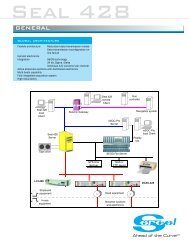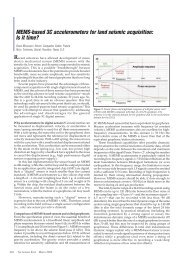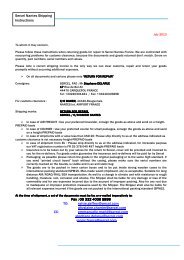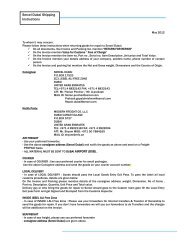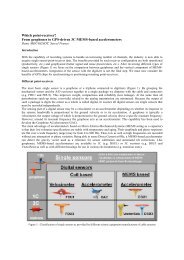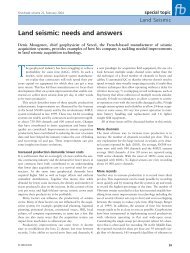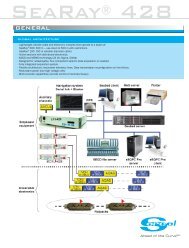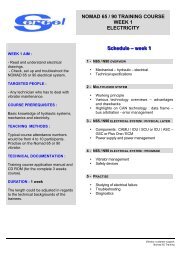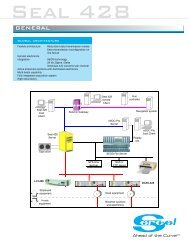How technology drives high-productivity vibroseis - Sercel
How technology drives high-productivity vibroseis - Sercel
How technology drives high-productivity vibroseis - Sercel
- No tags were found...
You also want an ePaper? Increase the reach of your titles
YUMPU automatically turns print PDFs into web optimized ePapers that Google loves.
Geophysical Prospecting, 2012, 60, 602–607doi: 10.1111/j.1365-2478.2012.01069.x<strong>How</strong> <strong>technology</strong> <strong>drives</strong> <strong>high</strong>-<strong>productivity</strong> <strong>vibroseis</strong>: a historicalperspectiveDenis Mougenot ∗ and Daniel Boucard<strong>Sercel</strong>, B.P. 30439, 44474 Carquefou Cedex, FranceReceived July 2011, revision accepted January 2012ABSTRACTThe development of <strong>high</strong>-<strong>productivity</strong> seismic recording using the <strong>vibroseis</strong> methodover the last 30 years is treated from a <strong>Sercel</strong> perspective. The simultaneous use ofvibrators has been <strong>high</strong>ly dependent on real-time field computing capabilities such asthose delivered by the correlator-stackers in the early 1980s. A second step forward inthe mid 1980s–early 1990s was related to digital vibrator electronics, which providesefficient management and quality control of fleets of vibrators. <strong>How</strong>ever, it was onlyin the late 1990s with the advent of real-time satellite positioning (GPS) of these fleetsthat alternate or simultaneous sweeping was commonly used in production. Duringthe last ten years, thanks to GPS timing, continuous data recording and innovativesimultaneous sourcing methodologies, <strong>vibroseis</strong> has been able to reach unexpectedlevels of <strong>productivity</strong>. As a result, the cost per seismic trace has dropped, enablingdenser spatial sampling and associated seismic imaging improvement.Key words: Correlator-stacker, Vibroseis.INTRODUCTIONCompared to marine seismic acquisition, land <strong>vibroseis</strong> is particularlysuitable for simultaneous sourcing because of the relativelylow cost of adding vibrators. The emitted signal, easilyparametrized to design multiple sweeps as well as a variablestart times (T0), makes it possible to extract the contributionfrom each of the sources. Although the theoretical capabilitiesof <strong>vibroseis</strong> are obvious, their operational implementationlagged until advances in electronics, computer power, wirelesstransmissions and the Global Positioning System (GPS) madeit possible to manage multiple fleets of vibrators in real-timeover large distances. The result has been a tremendous increasein land seismic crew <strong>productivity</strong> by multiple orders ofmagnitude (from several hundred Vibration Points (VP’s) perday to more than 10 000 VP’s/day), at least in open terrain.Below is a description, essentially based on <strong>Sercel</strong> acquisitionsystems, of the developments from the early 1980s until the∗E-mail: denis.mougenot@sercel.comlast decade that were successfully applied for acquisition inthe Middle East and North Africa.THE EARLY 1980sField correlator-stacker and the first simultaneous vibratorsSimultaneous <strong>vibroseis</strong> recording started in the early 1980swhen electronic memories and processors became compactand affordable enough to be gathered in racks that could beput into a recorder to perform real-time correlation and stackingof the vibration points. In 1981, a field correlator-stackersuch as the <strong>Sercel</strong> CS 2502 required the assembly of 300 CentralProcessing Units (CPUs) into a large card, each one able toprocess two channels at a 2 ms sampling rate. Correlation wasperformed in the time-domain and multiple sweep stacking offeredthe possibility to attenuate ambient as well as impulsenoise. The maximum capability was only 240 channels (Fig. 1)but the benefits were many: data volume reduction by summingand correlating to an amount that could be written totape and real-time display of the VP’s for Quality Controls602 C○ 2012 European Association of Geoscientists & Engineers
<strong>How</strong> <strong>technology</strong> <strong>drives</strong> <strong>high</strong>-<strong>productivity</strong> <strong>vibroseis</strong> 603Figure 1 Chronology of the correlator-stackers with examples based on <strong>Sercel</strong> acquisition systems. Channel capability is real-time at a 2 mssampling rate.CS: Correlator-Stacker; SN: Système Numérique; APM: Acquisition and Processing Module;CMXL: Control Module of eXtraLarge capacity; UL: Ultra Link; XL: eXtra Large.(QC’s). Hence, significant time was saved during data processing.By interfacing two CS 2502s, the correlator-stackercapability was extended to two simultaneous fleets of vibratorsusing two different sweeps. Thanks to encoding (plusminus,phase rotation and/or up-down sweeps), correlationand sweep stacking enabled the cancellation of the contributionfrom the other source to a certain extent (–25 dB to –35 dBpractically).Simultaneous vibrators were tested as early as 1982 inFrance (Garotta 1983, 1987) to speed up 3D acquisition byshooting on each side of a receiver spread. The same approachwas also implemented in various domains including:the mix of a low-frequency sweep array with a single-point<strong>high</strong>-frequency sweep (Garotta and Pennacchioni 1985); therecording of deep refraction data at the same time as a normalsurvey (Garotta 1986); the simultaneous VSP acquisition fromdifferent offsets or azimuths (Naville 1984); the combined useof P and S vibrators in different frequency ranges.At that time, pilot generation and sweep control inside thevibrator were still analogue (e.g., the GeoSource 310C or thePelton Advance 1). No real-time sweep QC’s were availablein the recorder, except the print-out of the correlated VP’s.THE MID 1980s–EARLY 1990sDigital vibrator electronics offers new capabilitiesBy the mid 1980s, the conventional analogue phase-lock systemswere replaced by the first vibrator electronics capable ofphase and force control (e.g., the Pelton Advance II and theTexas Instrument VCS V; Glenn, Alvi and Shoffner 1984).At the end of the 1980s, the first 3D acquisitions using thephase-encoded <strong>high</strong>-production <strong>vibroseis</strong> mode were completed.Among the largest were the surveys in Prudhoe Bay(480 live channels, two vibrator groups) and over the Dollarhidefield TX (384 live channels; two vibrator groups), thelatter with a 35% <strong>productivity</strong> increase (Reblin et al. 1990,1991).In 1988, the first digital servo-controlled vibrator electronicsbased on a numerical model of the vibrator and ofthe ground below the baseplate was introduced by <strong>Sercel</strong>(VE416; Garotta 1990; Boucard and Ollivrin 2010; Fig. 2).Like the other controllers, VE416 was split into two componentscommunicating by radio (VHF). The Digital PilotGenerator (DPG) in the recorder was able to generate a largechoice of digital pilots, including random sweeps (Burger andBaliguet 1992). The Digital Servo Drive (DSD) was placedin each vibrator to perform an auto-adaptive control of theemitted groundforce. At the beginning, the sweeps started atregular intervals selected to be longer than the move-up time.Soon, the observer became able to manually trigger the sweepafter a ‘ready tone’ was sent by the drivers. After the sweepsome QC’s were transmitted from which the observer wasable to evaluate on prints the discrepancy between the pilotsignal and the emitted groundforce (peak force, phase anddistortion). Up to four simultaneous fleets of vibrators weremanaged from a single radio frequency but this capability didnot have a significant impact on operations due to the limitedefficiency of the source separation at that time. In practice, toomany sweeps were required to separate the cross-correlationof the harmonics with the fundamental of the other sweeps.Therefore, it was not a significant time-saver (Lansley, writtencommunication). Alternate sweeps (flip-flop) started to beC○ 2012 European Association of Geoscientists & Engineers, Geophysical Prospecting, 60, 602–607
604 D. Mougenot and D. BouchardFigure 2 Chronology of the vibrator electronics with examples based on <strong>Sercel</strong> acquisition systems.VE: Vibrator Electronics; GPS: GlobalPositioning System; DPG: Digital Pilot Generator; DSD: Digital Servo Drive.implemented in Oman in 1991 (Onderwaater, Wams and Potters1996; Wams and Rozemond 1998) but with only twofleets each vibrating along a zig-zag pattern.At the same time, the capabilities of the field correlatorstackerimproved thanks to the ability of processors to correlatein the frequency domain (e.g., the <strong>Sercel</strong> CS 260 in 1988,Fig. 1). This evolution was mandatory to handle the increasingnumber of channels made available (e.g., 1200 channelsreal-time at 2 ms with the <strong>Sercel</strong> SN388).THE LATE 1990sGPS positioning and the start of <strong>high</strong>-<strong>productivity</strong> <strong>vibroseis</strong>Significant progress to improve efficiency with vibratorrecording occurred in the late 1990s thanks to a new generationof vibrator electronics (e.g., the Pelton Vib Pro and the<strong>Sercel</strong> VE432; Fig. 2), which were inter-compatible with themain recording systems. GPS positioning was integrated notonly for QC purposes but also to be able to manage differentfleets of vibrators in alternate (flip-flop and slip-sweep) or simultaneous(HFVS; Allen, Johnson and May 1998; Wilkinsonet al. 1998) modes. Thanks to real-time differential satellitepositioning (DGPS), vibrator fleets could transmit in the digital‘ready tone’ the position of the Centre of Gravity (CoG)of their baseplates. Then, the recorder uses this position tofind the corresponding pre-planned VP and starts the acquisitionaccordingly (i.e., with the correct associated spread).This ‘navigation’ mode requires the capability to network allthe vibrators of the same fleet by WiFi via an Ethernet bridgeto define their CoG. Then, the central unit forms the spreadcorresponding to this CoG and checks the status of the othersources before triggering the corresponding VP. This of courserequires reliable radio communications that could start thevibrator at a long distance and return vibrator QC data to theobserver for their examination on the recorder screen.Flip-flop became common in terrain where short move-uptime was possible and with three fleets saw a doubling of production(up to 180 VP’s/hour) with respect to a single fleet.Close collaboration between Petroleum Development Omanand <strong>Sercel</strong> led to the first slip-sweep tests being performed(1995–1998) (Rozemond 1996; Burger, Duijndam andWasmuth 1999). The methodology was soon implementedin production in Oman (Fig. 3; Mahrooqi et al. 2008) and inNorth Africa (Thacker et al. 2000). <strong>How</strong>ever, its acceptancewas limited outside Oman due to equipment constraints (onespecific vibrator electronics (DPG) and one radio frequencyrequired per fleet of vibrators) and to the clients reluctance toadopt new methodologies.At the same time, the correlator-stacker became even morecompact and an integrated part of the central unit (e.g., theAPM of the <strong>Sercel</strong> SN388 recording system; Fig. 1).FIRST DECADE OF THE 21 st CENTURYThe boom of <strong>vibroseis</strong> <strong>productivity</strong>The last ten years have seen an increase in <strong>vibroseis</strong> <strong>productivity</strong>to unprecedented levels (Fig. 4) as the result of theintroduction of new technologies, which have enabled thedevelopment of innovative methodologies (Bagaini 2010).Examples of these new field acquisition techniques are: aggressiveslip-sweep with short slip-time as used in CGGVeritasV1 methodology; simultaneous sweeping as implemented inBP’s Distance Separated Simultaneous Sweeping (DSSS) andIndependent Simultaneous Sweeping (ISS 1 ). The first major1 ISS is a trademark of BP.C○ 2012 European Association of Geoscientists & Engineers, Geophysical Prospecting, 60, 602–607
<strong>How</strong> <strong>technology</strong> <strong>drives</strong> <strong>high</strong>-<strong>productivity</strong> <strong>vibroseis</strong> 605Figure 3 Chronology of simultaneous <strong>vibroseis</strong> sourcing.HFVS: High-Fidelity Vibroseis Seismic; ISS: Independent Simultaneous Sweeping;DSSS:Distance Separated Simultaneous Sweeping.Figure 4 High-<strong>productivity</strong> <strong>vibroseis</strong> records from different methodologies during the last ten years as obtained by a combination of 428XLand VE464 in operations.improvement came with the recording systems (e.g., the <strong>Sercel</strong>408UL and 428XL) providing lighter equipment whose quickdeployment and activation in the field complemented <strong>high</strong>ersource <strong>productivity</strong>. They also contributed to an increase inchannel count over the past decade from 10 000 to over100 000 currently recorded (in real-time at 2 ms). Sufficientcomputer power and memory were made available to processsimultaneous sources. The major step involved removingthe dedicated correlator-stacker hardware and implementingthese operations in software. Recently (since 2005; Fig. 2)this number-crunching no longer involved a specific memorycard as it was able to directly benefit from the several tens ofgigabytes available in the central unit server’s memory.The second major evolution has been the synchronizationof the recorder and the vibrators by GPS timing. With the latestgeneration of vibrator electronics (e.g., the <strong>Sercel</strong> VE464 in2007) radio transmission is digital, multiplexed and synchronizedby GPS (Time Division Multiple Access or TDMA). Thisnot only increases the capabilities on offer (up to 32 vibratorfleets managed by a single radio frequency) but also thetransmission range and the flexibility (recording time-zero(T0) becomes the GPS time at which we would like the vibratorto sweep). TDMA transmission has become a standard.It is used by other vibrator electronics such as the Pelton VibPro and the Seismic Source Co. Force III when they are complementedby a TDMA communication module. Within eachvibrator new capabilities are made available such as the guidancefor stakeless acquisition and an improved recording ofthe groundforce (formatted as a SegD file by VE464) and relatedcontrol attributes (one phase, peak force and distortionvalue every 0.5 s instead of the average value during the sweeplength).With these improvements, slip-sweep has been freed fromprevious constraints (memory, radio frequency availabilityand range). In North Africa, surveys with 12 fleets of singlevibrators using long sweeps (e.g., 40 s) but a short sliptime(e.g., 5 s) were performed with production above 700VP’s/hour providing much denser spatial sampling on theC○ 2012 European Association of Geoscientists & Engineers, Geophysical Prospecting, 60, 602–607
606 D. Mougenot and D. Bouchardsource side (Meunier, Bianchi and Ragab 2007; Meunier et al.2008). Capitalizing on the very long spreads laid out in desertareas (more than 20 km-long receiver lines), BP prompted thesimultaneous use of widely separated flip-flop or slip-sweepfleets with their DSSS methodology, which depending on thenumber of vibrator groups theoretically doubles or triples <strong>productivity</strong>(Bouska 2008, 2009, 2010). Using this combinationof DSSS with slip-sweep average daily <strong>productivity</strong> above5500 VP’s/day was maintained for months by super-crewsin Oman (Matheny 2009). Pushing the limits further still, BPfreed vibrators and the recorder from the requirement of interactiveradio communication using their ISS approach, which isadaptable to hilly terrain that can cause radio shadows (<strong>How</strong>eet al. 2008). Thanks to GPS timing, the recorder is put in continuousrecording mode and each vibrator sweeps as soon asit is ready in the area of the spread that has been allocatedto it. With such a methodology, <strong>productivity</strong> of over 1000VP’s/hour was achieved with the drawback of a <strong>high</strong> level ofinterference between VP’s (blended acquisition). If communicationsare not possible between the recorder and vibrators,QC’s are not available in real-time, except warning insidethe vibrators when some QC thresholds are reached (VE464DSD). Using ISS with 18 fleets of single vibrators shootingsimultaneously over a fixed spread of about 10 000 channels,Argas was able in 2010 during a test for Saudi Aramco toachieve a <strong>productivity</strong> of 45 000 VP’s/day (Pecholcs et al.2010; Huo et al. 2011). This is where we are today andwe should acknowledge the paramount contribution madeby satellites (GPS) for both positioning and timing in such asimultaneous sourcing achievement.DISCUSSIONGoing furtherWhat may prevent <strong>high</strong>-<strong>productivity</strong> <strong>vibroseis</strong> from achievingfurther improvement? Adding new fleets of vibrators seems tobe an easy and cost-effective way to beat production records,while on the recorder side nothing has to change as long asyou operate in continuous recording mode. <strong>How</strong>ever, thereare still two important limiting factors. The first is the abilityof the observer to monitor ever <strong>high</strong>er numbers of independentsources to be sure that they are performing as required, unlessyou agree to shoot blind, as in BP’s ISS approach. For surean improved radio communication range and capacity wouldhelp in better vibrator control. The second is the necessarybalance between the source and the receiver efforts: it does notmake sense to complete a shot grid and then to stop becausethe receiver spread did not move accordingly. Lighter receiverstations, replacement of geophone strings by single sensorsand fewer batteries would help in speeding up the roll-outof the spread. For such issues, the use of a cableless systemmay be part of the solution although each unit requires itsown battery. Decimation of the receiver spread to a sparsegrid (e.g., 200 m x 200 m) as proposed by BP in its ISS nodalapproach also makes sense providing it is compensated bya dense shot grid and all real-time QC’s will be missing. Asoften, there will not be any universal recipe to further improve<strong>productivity</strong>, the solution having to be tailored for the localterrain conditions.CONCLUSIONSSpatial sampling, the new paradigmThis historical perspective of the recording equipment andtechnologies enabling very <strong>high</strong> <strong>vibroseis</strong> <strong>productivity</strong> illustratesthe many benefits of a close partnership in the seismicindustry. As soon as the real-time capabilities of recorders andvibrators were made available by the manufacturers, they wereimplemented in the field by the contractors via new methodologiesproposed by oil companies. Such quick interactionmade it possible for land crew <strong>productivity</strong> in open terrainto reach unexpected levels (20 000+ VPs/day in production,40 000+ VPs/day in test), well above what has been achievedin marine acquisition.We should not forget that a decisive step in this evolutionoccurred in the minds of people, which corresponds toa paradigm shift in the way we should consider land seismicacquisition. Data quality should not only be consideredfrom the point of view of the individual shot points but alsofrom the point of view of the final seismic image for whichspatial sampling by sources and receivers and the resultingtrace density matter. Thus, even if <strong>high</strong> <strong>productivity</strong> methodsreduce the quality of the single records due to the use ofsingle-vibrator, single-sweep emissions and to the interferencebetween overlapping VPs, we may expect the resulting densespatial sampling by the sources to make up for this. High tracedensity and associated advanced processing will preserve organizednoise from aliasing, attenuate random noise thanks to<strong>high</strong>er fold coverage and remove acquisition footprints. Suchan achievement would not have been economical without theincreasing capabilities of the recording systems and the innovativemethodologies of simultaneous sourcing.ACKNOWLEDGEMENTSThe authors would like to acknowledge their colleagues fromCGGVeritas and <strong>Sercel</strong> who were instrumental in developingC○ 2012 European Association of Geoscientists & Engineers, Geophysical Prospecting, 60, 602–607
<strong>How</strong> <strong>technology</strong> <strong>drives</strong> <strong>high</strong>-<strong>productivity</strong> <strong>vibroseis</strong> 607many of the equipment and associated methodologies thatcontributed to <strong>high</strong>-<strong>productivity</strong> <strong>vibroseis</strong>. The experienceand feedbacks given by Pierre Baliguet, Yves Delaprée, RobertGarotta, Malcolm Lansley and Julien Meunier were essentialin helping us reconstitute such a historical perspective. Wealso benefited from many detailed corrections and pertinentremarks made by anonymous reviewers. Their expertise hasbeen of great help.REFERENCESAllen K.P., Johnson M.L. and May J.S. 1998. High fidelity vibratoryseismic (HFVS) method for acquiring seismic data. 68th SEG meeting,New Orleans, Louisiana, USA, Expanded Abstracts, 140–143.Bagaini C. 2010. Acquisition and processing of simultaneous <strong>vibroseis</strong>data. Geophysical Prospecting 58, 81–99.Boucard D. and Ollivrin G. 2010. Developments in vibrator control.Geophysical Prospecting 58, 33–40.Bouska J. 2008. Distance Separated Simultaneous Sweeping: Theworld’s fastest <strong>vibroseis</strong> technique. EAGE <strong>vibroseis</strong> workshop,Prague, Czech Republic, Expanded Abstracts, D05, 67–69.Bouska J. 2009. Distance Separated Simultaneous Sweeping: Efficient3D <strong>vibroseis</strong> acquisition in Oman. 79th SEG meeting, Houston,Texas, USA, Expanded Abstracts, 1–5.Bouska J. 2010. Distance Separated Simultaneous Sweeping, for fast,clean, <strong>vibroseis</strong> acquisition. Geophysical Prospecting 58, 123–153.Burger P. and Baliguet P. 1992. New vibrator control concept offersindustrial use of pseudo random sweeps in populated area. 62ndSEG meeting, Expanded Abstracts, 687–689.Burger P., Duijndam B. and Wasmuth D. 1999. Marine productionlevels in land 3-D seismic. 69th SEG meeting, Expanded Abstracts,1–5.Garotta R. 1983. Simultaneous recording of several <strong>vibroseis</strong> lines.CGG Technical Series, 531.83.07, 1–12.Garotta R. 1986. Simultaneous recording of reflection and refractiondata using vibrators. 56th SEG meeting, Expanded Abstracts, POS2.11, 282–283.Garotta R. 1987. Simultaneous <strong>vibroseis</strong> multisource acquisition.CGG Technical Series, 564.87.04, 1–4.Garotta R. 1990. New development and perspectives in <strong>vibroseis</strong>mics.60th SEG meeting, Expanded Abstracts, 948–951.Garotta R. and Pennacchioni J.L. 1985. Using selective simultaneoussweeps within <strong>vibroseis</strong> patterns. 55th SEG meeting, ExpandedAbstracts, S13.6, 519–522.Glenn G., Alvi H. and Shoffner S. 1984. An Advanced VibratorControl System. 54th SEG meeting, Expanded Abstracts, S22.8,755–756.<strong>How</strong>e D., Allen A.J., Foster M.S., Jack I.J. and Taylor B.2008. Independent simultaneous sweeping. 70th EAGE Conference& Exhibition, Rome, Italy, Expanded Abstracts, B007, 1–5.Huo S., Tsingas C., Kelamis P., Xu H. and Pecholcs P. 2011. Deblendingthe simultaneous source data – Is it necessary? 73rd EAGEConference & Exhibition, Vienna, Austria, H028, 1–5.Mahrooqi S., Matheny P., Abri S. and Peck N. 2008. 10 years and60 slip-sweep 3Ds for <strong>productivity</strong> and seismic data quality. EAGE<strong>vibroseis</strong> workshop, Prague, Czech Republic, Expanded Abstracts,D01, 58.Matheny P., Sambell R., Mahrooqi S., Yarubi S. and Abri S. 2009.Evolution of the land seismic super crew. 79th SEG meeting, Houston,Texas, USA, Expanded Abstracts, 81–85.Meunier J., Bianchi T., Postel J. and Taylor R. 2008. The futureof <strong>vibroseis</strong> for <strong>high</strong>-density wide-azimuth land acquisition. FirstBreak 26, 87–91.Meunier J., Bianchi T. and Ragab S. 2007. Experimenting Single VibratorSeismic Acquisition. EAGE 69th Conference & Exhibition,London, UK, B005, 1–5.Naville Ch. 1984. A simple way to accelerate onshore multioffset/multimodeWSP acquisition using vibrators, 54th SEG meeting,Expanded Abstracts, S26–7, 826–828.Onderwaater J., Wams J. and Potters H. 1996. Geophysics in Oman.GeoArabia 1, 2, 299–324.Pecholcs P.I., Lafon S.K., Al-Ghamdi T., Al-Shammery H., KelamisP.G., Huo S., Winter O., Kerboul J.B. and Klein T. 2010. Over40,000 vibrator points per day with real-time quality control: Opportunitiesand challenges. 80th SEG Meeting, Denver, Colorado,USA, Expanded Abstracts, 111–115.Reblin M.T., Chapel G.G., Keller C. and Roche S.L. 1990. A 3-Dreflection seismic survey over the Dollarhide Field, Andrews Co.,Texas: Design, acquisition, and processing. 60th SEG meeting, ExpandedAbstracts, CH1.3, 163–168.Reblin M.T., Chapel G.G., Roche S.L. and Keller C. 1991. A 3-D reflectionseismic survey over the Dollarhide field, Andrews County,Texas. The Leading Edge, 11–16.Rozemond H.J. 1996. Slip-sweep acquisition. 66th SEG meeting, Denver,Colorado, USA, Expanded Abstracts, 64–67.Thacker P., Aitchison M., Bryan R. and Ras P. 2000. Simulation ofan aggressive slip-sweep scheme in the Western Desert, Egypt. 70thSEG meeting, Expanded Abstracts, 1–4.Wams J. and Rozemond J. 1998. Recent developments in 3-D acquisitiontechniques using <strong>vibroseis</strong> in Oman. The Leading Edge,1053–1063.Wilkinson K., Habiak R., Siewert A. and Millington G. 1998. Seismicdata acquisition and processing using measured motion signalson vibrators. 68th SEG meeting, New Orleans, Louisiana, USA,Expanded Abstracts, 1–5.C○ 2012 European Association of Geoscientists & Engineers, Geophysical Prospecting, 60, 602–607




